The 1953 Alfa Romeo 1900, a timeless masterpiece of Italian automotive engineering, emerged as a beacon of innovation and style in the post-war era. This elegant sports car, with its sleek lines and powerful engine, captured the hearts of enthusiasts worldwide, establishing Alfa Romeo as a leading force in the global automotive landscape.
The 1900 was more than just a car; it represented a bold statement of Italian design and engineering prowess. It was a testament to Alfa Romeo’s commitment to pushing the boundaries of performance and aesthetics, blending advanced technology with a timeless elegance that continues to captivate car enthusiasts today.
Historical Context
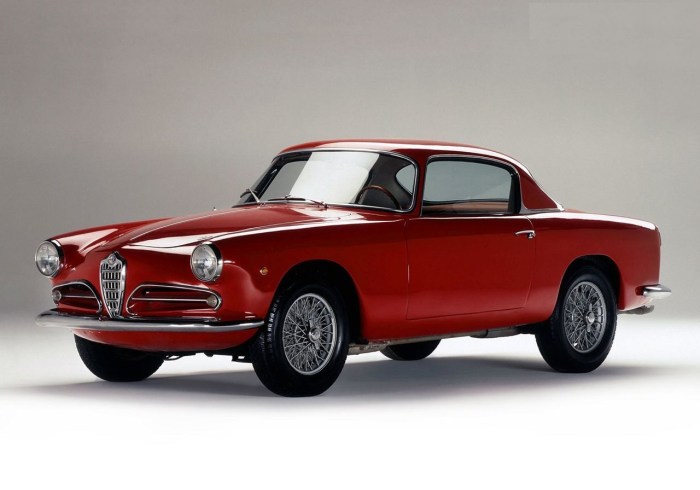
The 1953 Alfa Romeo 1900, a pivotal model in the Italian marque’s history, emerged during a period of significant transformation in the automotive industry. Post-World War II, the world witnessed a surge in demand for automobiles, fueled by economic recovery and a growing middle class.
The 1950s became a decade of innovation and design advancements, shaping the landscape of modern automotive engineering.The 1953 Alfa Romeo 1900 represented a departure from the traditional, handcrafted approach to car manufacturing, embracing new technologies and production methods. This era saw the rise of mass production techniques, with companies like Alfa Romeo striving to create automobiles that were both affordable and technologically advanced.
Technological Advancements
The 1953 Alfa Romeo 1900 was a testament to the technological progress of the era. Its design incorporated several key innovations, reflecting the advancements in materials, engineering, and production processes.
The 1953 Alfa Romeo 1900 was a groundbreaking car, renowned for its elegant design and powerful engine. It paved the way for a legacy of performance and style that continues to this day, exemplified by the modern 2021 Alfa Romeo Stelvio.
The Stelvio, with its sharp handling and Italian flair, embodies the spirit of the 1900, demonstrating how Alfa Romeo has consistently delivered vehicles that are both captivating and capable.
- Unitary Body Construction:The 1900 was one of the first production cars to feature a unitary body construction, a revolutionary approach that integrated the chassis and body into a single unit. This construction technique provided increased rigidity and strength, improving handling and safety while reducing weight.
- Double Overhead Camshaft Engine:The 1900 was powered by a 1.9-liter four-cylinder engine with double overhead camshafts, a configuration that was relatively uncommon at the time. This engine design delivered impressive performance and efficiency, setting a new standard for sports car engines.
- Independent Suspension:The 1900 featured independent front and rear suspension, a technology that was becoming increasingly popular in the 1950s. This design provided superior handling and ride comfort, enhancing the driving experience.
Socio-economic Factors, 1953 Alfa Romeo 1900
The popularity of the 1953 Alfa Romeo 1900 was not solely attributed to its technological advancements but also to the prevailing socio-economic conditions of the time. The post-war economic boom created a surge in demand for automobiles, particularly in Europe, where the 1900 was a popular choice.
- Growing Middle Class:The expanding middle class, with increased disposable income, fueled the demand for personal transportation. The 1900, with its stylish design and performance, appealed to this segment of the market.
- Rise of Sports Car Culture:The 1950s witnessed the rise of sports car culture, with models like the Alfa Romeo 1900 becoming symbols of style and performance. This cultural shift contributed to the car’s popularity, attracting enthusiasts and drivers who sought both speed and elegance.
- Post-War Optimism:The post-war period was characterized by optimism and a sense of renewal. The 1900, with its innovative design and sporty nature, reflected this optimistic spirit, becoming a symbol of progress and prosperity.
Design and Engineering
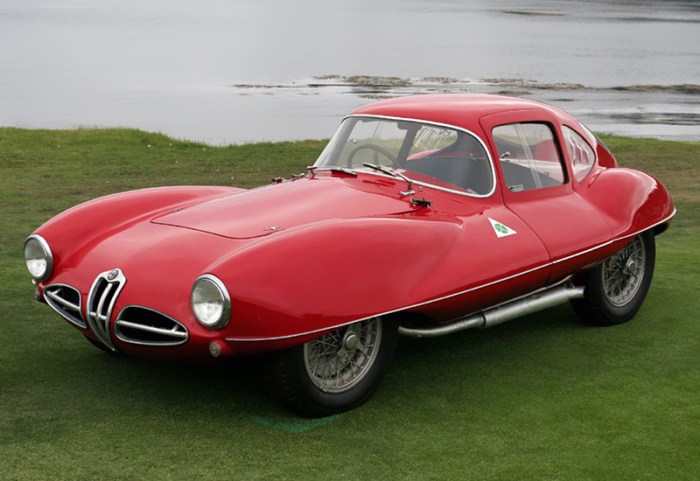
The 1953 Alfa Romeo 1900, a groundbreaking car of its time, embodied a blend of elegant design and innovative engineering, establishing a new benchmark in the automotive world. This car’s design philosophy prioritized performance, handling, and aesthetics, setting it apart from its contemporaries.
Engine
The 1900’s engine was a marvel of engineering. It was a 1.9-liter, four-cylinder, inline engine, featuring a twin overhead camshaft (DOHC) design. This engine design, while not entirely novel, was considered advanced for its time. The DOHC configuration allowed for more precise valve control, resulting in superior power and efficiency.
The engine produced a respectable 90 horsepower, making it one of the most powerful cars of its era.
The 1953 Alfa Romeo 1900 was a revolutionary car, pioneering a new era of performance and style for the Italian marque. This legacy continued into the 1970s with the 1971 Alfa Romeo 1750 GTV , a car that carried the torch of elegance and driving passion.
While the 1900 was a testament to post-war innovation, the 1750 GTV solidified Alfa Romeo’s position as a maker of desirable sports cars, further emphasizing the brand’s commitment to performance and craftsmanship.
Chassis and Suspension
The 1900’s chassis was designed for both strength and lightness. It was constructed from a tubular steel frame, a design choice that provided rigidity while keeping weight down. The suspension, a double wishbone setup in the front and a live axle with semi-elliptic leaf springs in the rear, offered a balance of ride comfort and handling precision.
This setup was considered a significant improvement over the rigid axles commonly used in cars of that era.
Comparison with Contemporaries
The 1953 Alfa Romeo 1900 stood out from its contemporaries, particularly in terms of its performance and handling. While other manufacturers were still using traditional engine designs and suspension systems, Alfa Romeo was pushing the boundaries of automotive engineering.
The 1900’s DOHC engine and sophisticated suspension system allowed it to outperform many of its rivals, especially in terms of acceleration and cornering. The car’s elegant design, characterized by its flowing lines and distinctive grille, also set it apart from the more conservative designs of the time.
Performance and Handling
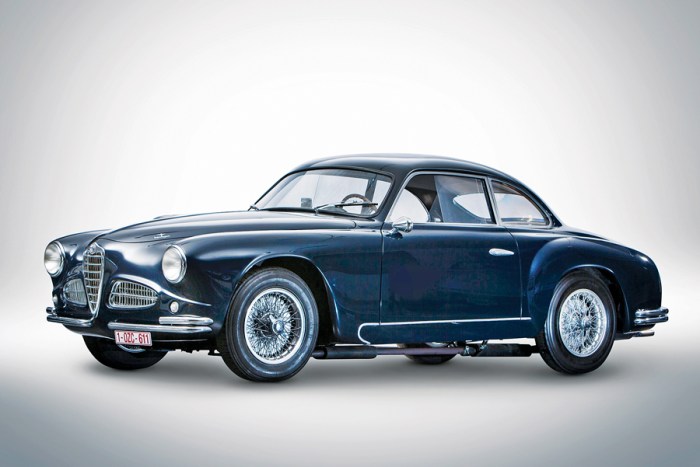
The 1953 Alfa Romeo 1900 was a remarkable car that combined elegance with impressive performance. Its engine, suspension, and overall design contributed to its reputation as a sporty and agile vehicle.
Performance Characteristics
The 1900 was powered by a 1.9-liter, four-cylinder engine that produced 90 horsepower. This engine was renowned for its smooth and responsive nature, delivering a thrilling driving experience. The 1900’s acceleration was impressive for its time. It could reach 60 mph in around 13 seconds and had a top speed of approximately 100 mph.
These figures were competitive with other sports cars of the era, showcasing the 1900’s performance capabilities.
Driving Experience
The 1900’s driving experience was characterized by its responsiveness, agility, and engaging handling. The car’s lightweight construction and well-balanced chassis allowed for precise and predictable handling, making it a joy to drive on winding roads. The steering was direct and communicative, providing the driver with a strong connection to the road.The 1900’s suspension, with its independent front and rear setup, provided a comfortable ride while maintaining excellent handling characteristics.
The car’s relatively low center of gravity further contributed to its stable and predictable handling.
The 1953 Alfa Romeo 1900 was a groundbreaking car, introducing a revolutionary lightweight construction and a powerful engine. This pioneering spirit continued in later Alfa Romeo models, including the iconic 1971 Alfa Romeo Spider , which further refined the Italian brand’s focus on performance and style.
The 1900, however, remains a testament to Alfa Romeo’s commitment to pushing boundaries, setting the stage for the brand’s future successes.
Impact of Performance on Reputation
The 1953 Alfa Romeo 1900’s performance played a significant role in its reputation and legacy. Its impressive acceleration, top speed, and agile handling made it a popular choice among enthusiasts and racing drivers. The 1900’s success in motorsport, particularly in touring car racing, further solidified its reputation as a capable and sporty vehicle.
The 1900’s performance legacy continued to influence subsequent Alfa Romeo models, establishing the brand’s reputation for producing high-performance and stylish vehicles.
Legacy and Impact
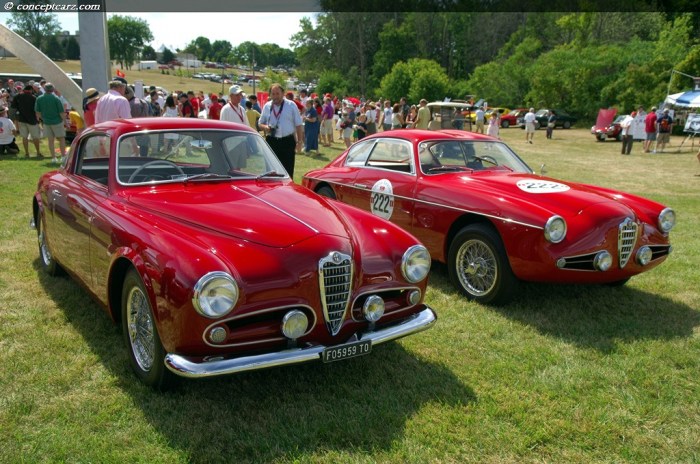
The 1953 Alfa Romeo 1900, a pioneering model that blended elegance with performance, left an enduring mark on the automotive landscape. Its innovative design, advanced engineering, and motorsport success cemented its place as a legend, shaping the future of Alfa Romeo and influencing the industry at large.
Impact on Future Alfa Romeo Models
The 1900’s influence on subsequent Alfa Romeo models is undeniable. It established a design language that would define the brand for decades to come. The sleek, aerodynamic bodywork, the signature grille, and the use of lightweight materials all became hallmarks of Alfa Romeo’s design philosophy.
Moreover, the 1900’s innovative engineering solutions, such as the double overhead camshaft engine and the independent suspension, were further developed and refined in later models. This continuous evolution, inspired by the 1900’s groundbreaking features, contributed to Alfa Romeo’s reputation for building powerful and sophisticated cars.
Cultural Significance and Motorsport Success
The 1953 Alfa Romeo 1900 transcended its role as a mere vehicle, becoming a cultural icon. Its stylish design and sporting prowess captured the imagination of the public, making it a symbol of Italian automotive excellence. This allure was amplified by its remarkable success in motorsport.
The 1953 Alfa Romeo 1900 was a groundbreaking car, introducing a lightweight, powerful engine and elegant design that set the stage for future Alfa Romeos. Its legacy can be seen in the iconic 1964 Alfa Romeo Giulia Spider , which inherited the same passion for performance and style.
The Giulia Spider, with its sleek lines and spirited engine, continued the tradition of driving pleasure established by the 1900, solidifying Alfa Romeo’s position as a leader in Italian sports car design.
The 1900, particularly in its “Corsa” and “Sprint” variants, dominated racing circuits, winning prestigious events like the Mille Miglia and the 24 Hours of Le Mans. These victories further solidified its reputation as a formidable competitor and a symbol of Italian racing prowess.
The 1953 Alfa Romeo 1900 was a revolutionary car, introducing a new level of performance and sophistication for the brand. Its legacy continued with the 1966 Alfa Romeo 2600 , a refined and luxurious iteration that further cemented Alfa Romeo’s reputation for elegance and driving pleasure.
The 1900, however, remained a cherished symbol of Alfa Romeo’s innovative spirit, paving the way for future generations of iconic sports cars.
Influence on Popular Culture
The 1900’s impact extended beyond the automotive world, influencing popular culture in various ways. Its sleek design and sporting heritage made it a popular choice for films and television shows, often appearing as a symbol of wealth, sophistication, and speed.
For example, the 1900 was featured in the 1969 film “The Italian Job,” adding to its cinematic allure. Moreover, the 1900’s legacy lives on in the hearts of car enthusiasts worldwide, inspiring countless replicas and restorations, ensuring its enduring appeal.
Notable Variants and Special Editions
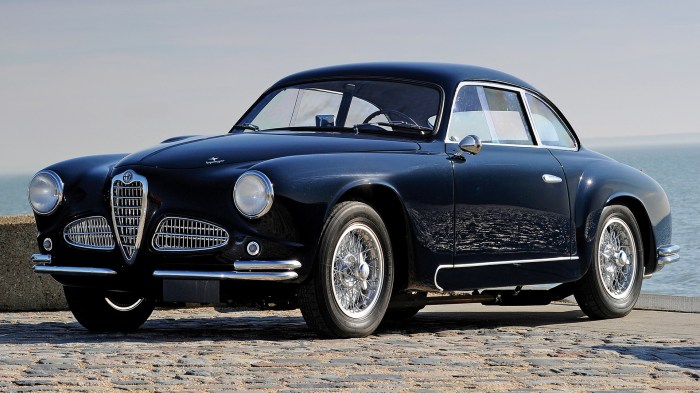
The Alfa Romeo 1900, a revolutionary car for its time, spawned several notable variants and special editions that catered to different needs and desires. These variations, while retaining the core design and engineering principles of the original, offered unique features, performance enhancements, and styling variations that further solidified the 1900’s position as a legend.
Variants and Special Editions
The following table provides an overview of some of the most significant variants and special editions of the 1900:
| Variant Name | Year of Production | Key Features | Significance |
|---|---|---|---|
| 1900 Super | 1954-1958 | Increased engine power (115 hp), revised suspension, and more luxurious interior. | Enhanced performance and comfort, making it a popular choice for both road and track use. |
| 1900 Sprint | 1952-1955 | Lightweight, aerodynamic bodywork, and a more powerful engine (110 hp). | One of the first production sports cars, renowned for its speed and handling, and a successful competitor in motorsport. |
| 1900 C | 1953-1956 | Two-door coupé body style, luxurious interior, and a powerful engine (100 hp). | Offered a more elegant and sophisticated alternative to the standard saloon, appealing to a discerning clientele. |
| 1900 Ti | 1954-1955 | Lightweight, aerodynamic bodywork, and a powerful engine (110 hp). | A more focused and track-oriented version of the 1900 Sprint, with even better performance and handling. |
| 1900 Berlina | 1950-1959 | Four-door saloon body style, spacious interior, and a range of engine options. | The most popular and versatile variant, offering a comfortable and practical driving experience. |
| 1900 Spider | 1954-1958 | Two-door convertible body style, sporty design, and a powerful engine (100 hp). | Offered an open-air driving experience and became a popular choice for enthusiasts seeking a blend of performance and style. |
| 1900 Zagato | 1954-1955 | Lightweight, aerodynamic bodywork designed by Zagato, and a powerful engine (110 hp). | A limited-production, hand-built sports car known for its stunning design and impressive performance. |
Contemporary Reviews and Opinions: 1953 Alfa Romeo 1900
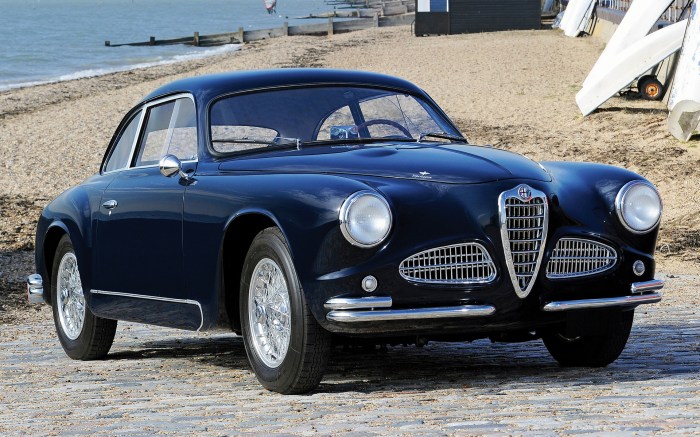
The 1953 Alfa Romeo 1900 received a generally positive reception from automotive publications of the era, praised for its performance, handling, and stylish design. However, some reviewers noted its high price and limited practicality.
Critical Reception of the 1950 Alfa Romeo 1900
Contemporary reviews highlighted the 1900’s strengths and weaknesses, shaping public perception.
Strengths
- Performance and Handling:The 1900’s powerful engine and responsive handling were widely lauded. Reviewers praised its acceleration, top speed, and ability to corner with precision.
- Design:The 1900’s elegant and modern design was a key selling point. Its flowing lines and sophisticated details were admired for their aesthetic appeal and aerodynamic efficiency.
- Driving Experience:Reviewers emphasized the 1900’s engaging and rewarding driving experience, characterized by its responsiveness, precision, and overall refinement.
Weaknesses
- Price:The 1900 was considered expensive for its time, making it a luxury purchase beyond the reach of many buyers.
- Practicality:Some reviewers criticized the 1900’s limited practicality, pointing to its small interior and limited cargo space.
- Reliability:While the 1900’s engineering was sophisticated, some reviewers noted that its reliability could be inconsistent, particularly in the early years of production.
Public Perception
The 1953 Alfa Romeo 1900 was generally perceived as a desirable and prestigious car, appealing to those seeking performance and style. Its high price and limited practicality meant it was not a mainstream car, but it nevertheless gained a strong following among enthusiasts and those who appreciated its sporting character.
Visual Representation
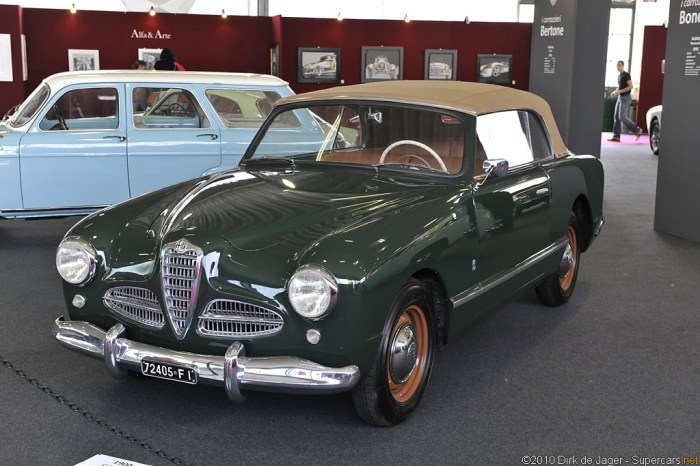
The 1953 Alfa Romeo 1900 is a captivating example of Italian automotive design, blending elegant lines with a sporty, purposeful stance. Its distinctive features, from the flowing curves of its bodywork to the intricate details of its interior, have solidified its place as an icon in automotive history.
Exterior Design
The exterior design of the 1950 Alfa Romeo 1900 is characterized by its sleek, aerodynamic lines and graceful proportions.
- The front end features a prominent grille with a distinctive “V” shape, flanked by large, rounded headlights. The grille’s vertical bars are a signature design element, adding a touch of sophistication to the car’s face.
- The long, flowing hood seamlessly transitions into the rounded fenders, creating a harmonious and elegant silhouette. The fenders are accentuated by a subtle curve, highlighting the car’s muscular character.
- The rear end is equally well-proportioned, with a gracefully sloping roofline that blends into a rounded rear deck. The integrated tail lights, with their distinctive circular shape, contribute to the car’s overall visual appeal.
- The 1900’s bodywork was meticulously crafted, with smooth, flowing surfaces and minimal ornamentation. This minimalist approach emphasized the car’s inherent beauty and streamlined design.
Interior Design
The interior of the 1953 Alfa Romeo 1900 is a testament to Italian craftsmanship, combining elegance and functionality.
- The dashboard is a masterpiece of simplicity and elegance, with a minimalist layout that prioritizes functionality. The instruments are neatly arranged, with clear, easy-to-read gauges. The use of high-quality materials, such as leather and polished metal, further enhances the interior’s luxurious feel.
- The seats are well-contoured and supportive, providing both comfort and a sense of sportiness. The use of high-quality leather upholstery adds a touch of luxury to the cabin.
- The overall design of the interior emphasizes driver focus, with everything within easy reach. This practical approach complements the car’s sporty character.
Visual Appeal
The 1953 Alfa Romeo 1900 possesses an undeniable visual appeal, a timeless elegance that has captivated car enthusiasts for decades. Its sleek lines, balanced proportions, and intricate details create a harmonious and unforgettable aesthetic. The car’s design, a perfect blend of sportiness and sophistication, has earned it a place among the most iconic cars of the 20th century.
Its influence can be seen in countless later designs, solidifying its position as a true automotive legend.
Final Conclusion
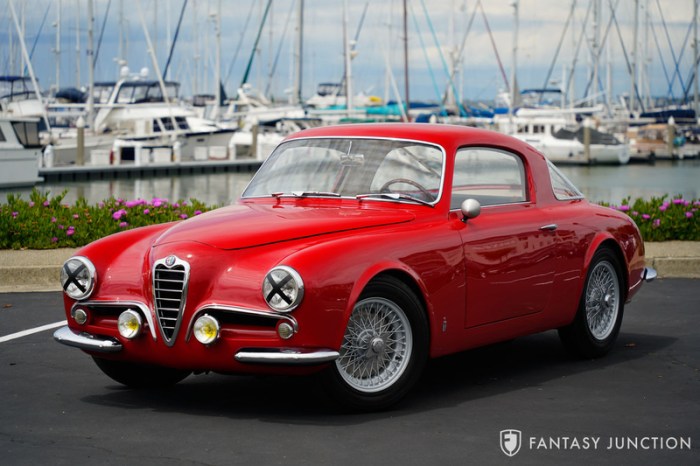
The 1953 Alfa Romeo 1900 stands as a testament to the enduring legacy of Italian automotive artistry. Its blend of elegance, performance, and innovation continues to inspire and captivate car enthusiasts worldwide, cementing its place as a true icon of the golden age of sports car design.
This car’s enduring popularity and influence on subsequent Alfa Romeo models are a testament to its timeless appeal and enduring legacy.